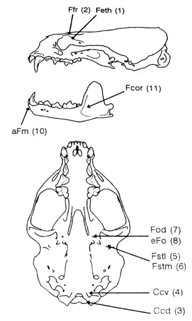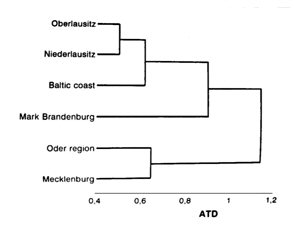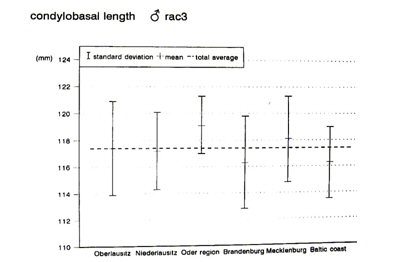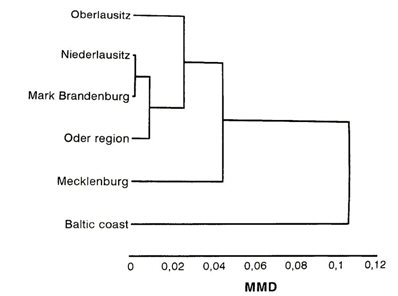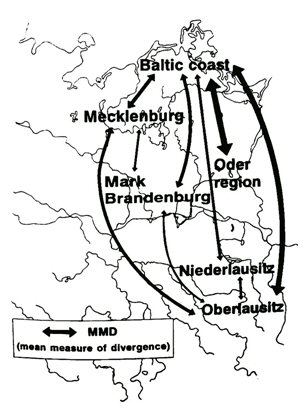 |
Last Update:
Thursday November 22, 2018
|
| [Home] |
|
Volume 11 Pages 1 - 57 (April 1995) Citation: Ansorge, H. and Stubbe, M. (1995) Nonmetric Skull Divergence in the Otter - Assessing Genetic Insulation of Populations . IUCN Otter Spec. Group Bull. 11: 15 - 24 Nonmetric Skull Divergence in the Otter - Assessing Genetic Insulation of Populations 1 Staatliches
Museum für Naturkunde Görlitz, PF 300154, D-02806 Görlitz,
Germany
Genetic insulation is one of the most reliable indications to show where species are endangered or on further decrease. The situation of the otter Lutra lutra (Linné, 1758) in Western and Central Europe gives an example. In many parts of this area the population splittings have been followed by considerable decrease or extinction (Reuther, 1992). Until now in the eastern part of Germany there have been otter occurrences of high density and vital condition. Obviously the important losses of otters mainly by road killing seems to be compensated by healthy population parts with stable reproduction. However, recent surveys provide a picture of patchy otter distribution in East Germany too (Labes et al., 1989; Ansorge and Striese, 1993; Dolch et al., 1993) (Table 1). In addition, there is little knowledge of the problem that there were already genetic differences between these populations keeping not directly in reproductive contact. Besides cytogenetical and biochemical techniques the classic morphological skull studies can be used to obtain information about the populations divergence. Checking qualitative skull characters the evaluation of "epigenetic distances" between the populations is able to solve the question above. MATERIAL AND BASIC METHODS The study is based on 430 skulls of the river otter originating from several natural regions of East Germany (Figure 6). Most of the whole material was collected as road victims over the last ten years by the Zoologisches Institut der Universität Halle, the Museum der Westlausitz Kamenz and the Staatliches Museum für Naturkunde Görlitz. The studied otters were classified into three "relative age classes" (RAC) after Reig and Ruprecht (1989) grouping the skulls with identical stage of development. This classification depends on the general obliteration of sutures, the development of the postorbital constriction, the sagittal crest, the bone deposition around canine alveoles and the surface structure of brain-pan. The abrasion of teeth seems to be unsuitable even for an approximate age estimation of the otter skulls. According to the methodic experiences of Bree et al. (1966), Stubbe (1969), Heggberget (1984), Skarén (1987) and Uthleb et al. (1992) the relative age classes 1, 2 and 3 stand for juvenile, subadult and adult specimens. In addition most adult otters were aged by the configuration of incremental cementum lines applying an efficient method of low speed sawing (Driscoll et al., 1985; Ansorge, in press). To characterize potential differences in skull size 10 linear dimensions (Table 2, Figure 1) were used corresponding with the measurements defined by Driesch (1976).
All data were statistically processed by the mean (x), the range (xmax, xmin), the standard deviation (s), the variability coefficient (v= 100 s/x ) and Student's t-test to secure significance of mean differences (α < 0.05). As well each population group was computed separately according to sexes, age classes and regions. Metric similarity of the region samples was calculated by the "average taxonomic distance" (ATD) based on sample means of adult males. Clustering on the ATD matrix was performed by "unweighted pair group method with arithmetic average" (UPGMA) both using NTSYS-pc (Numerical Taxonomy and Multivariate Analysis System) (Rohlf, 1994). To determine the morphological differentiation with regard to the epigenetic distances, 12 non-metrical traits were checked. The characters have been chosen according to the rare investigations on other carnivores (Sjovold, 1977; Wiig and Lie, 1984; Wiig and Andersen, 1988; Ansorge, 1992) and own preliminary studies (Table 3, Figure 2).
Bilateral traits were taken from both sides of the skull and separately as well as together calculated. The frequencies of trait expressions were compared by the chi-square test including the analyse of homogeneity in age and sex. For computing the epigenetic distances the formula of "mean measure of divergence" (MMD) proposed and derived by Sjovold (1977) could be used. Variance and standard deviation (SMMD) of the MMD are necessary to prove statistic significance by MMD > 2 SMMD. Tree matrix and phenogram of MMD were computed by cluster analysis (UPGMA of NTSYS-pc). RESULTS However, the UPGMA tree diagram of Figure 3 shows distinct clusters
by the ATD ("average taxonomic distance") concerning otter
populations of similar skull measures:
The size differences can be illustrated by the range of variation in skull length (cbl) in Figure 4.
The evaluation of nonmetric characters yielded seven features with sufficient regional differences determined by the MMD (mean measure of divergence) - Table 6 But three of them (Feth, Ffr, Fcor) had to be excluded from further investigation because sex or age dependence was significantly proved for these traits.
In addition the epigenetic distance between the western and the eastern part of the Oberlausitz pondland was checked to receive a methodical standard value. As expected the low MMD = 0.03 (SMMD = 0,01) indicates the level of populations being closed or closely related as well as emphasizes the siutability of the method. Between the studied populations there are only small differences in skull size showing statistical significance in few measurements. The measure means in Table 4 (male RAC 3) allow the indication of a not directed size pattern. Therefore the complete basic statistic of all adult otters from the studied area is given in Table 5. In the mammalogy morphometric differences are favourably used as criteria for taxonomic classification below the species level. But these are based as on genetically fixed morphological variation as also on the modifications induced by environmental factors in a broad sense. In this account there could appear size differences between the animals of adjoining populations without any taxonomic relevance. Thus the studied skull samples of the otter from Eastern Germany show no clinal variation but a mosaic-like size pattern. These regional differences in skull size seems to be compensated in greater distances (Figure 4). Surely the semiaquatic habits of the otter equalize the unknown factors system affecting body size. According with this Hysing-Dahl (1959) and Zejda and Voskar (1987) remark the lack of regional variability in Norwegian and Czechoslovakian otters. There are only few useful series of measures from other parts of the European area to estimate the geographic variation of the species (Norway: Hysing-Dahl, 1959; Czechoslovakia: Zejda and Voskar, 1987; Central Finland: Skarén, 1987; Belorussia: Sidorovic, 1990; European part of Russia: Zejda and Voskar, 1987; Germany: present study). Considering the restrictions by age and sex no clinal variation can be detected in relation to otters of Eastern Germany. Certainly the skull size of the otter is not sufficient to indicate separated populations. To evaluate geographic differentiation of mammal populations further detailed findings have been adduced by the study of qualitative morphological skull characters. They are of different biological relevance than dimensions of the skull. These non-metrical traits seems to be slightly influenced by environmental factors. Being affected by genetic components the occurrence of the qualitative features does not randomly arise. For the estimation of the traits heritability see also Hilborn (1974), Berry (1975), Korey (1980) and Richtsmeier and McGrath (1986). However the morphological differentiation by nonmetric characters gives a certain measure of the epigenetic populations distance. The results obtained by this method show a largely different view than the craniometric variation among the East German otters (compare Figure 3 with Figure 5). Considering the divergence grouping (Figure 5) and the geographic situation (Figure 6) there is a cluster of four natural regions in the middle and southern part of the studied area. These regions show just as low epigenetic distances as the natural units within the Oberlausitz do it (see above). Therefore the otters of these areas do not belong to separate populations and live in reproductive connection.
But unexpected results were established by comparing morphological skull differentiation between the Baltic coast and the inland populations. There is a high degree of divergence segregating the otters of the coast from all the others. The large epigenetic distances point to a lower reproductive contact. Similar morphological differences were found by Sidorovich (1990) between the otter populations of two river systems in Byelorussia. But he used completely different skull characters influenced by muscle development and environmental factors. This prevents a directly comparison to this study. Further conclusions will not be meaningful until the divergence between completely separated populations will have been researched. Then the signs of a potential isolation could be estimated more precise. However the present study gives a good view of the differentiation of otter populations in Eastern Germany by their non-metric skull characters. According to that there do not exist a general genetic insulation among the centres of otter occurrences in this area. They seem to live in reproductive contact until now, perhaps except the otters from the Baltic coast. SUMMARY The craniometric variation and non-metric skull divergence between populations of the otter Lutra lutra (Linné, 1758) were studied using more than 430 skulls from different regions of Eastern Germany. No direct regional differences in skull measurements could be established for this area. The comparison of the morphological variation by non-metric skull characters adduces not or unimportant differentiations for most regions. Otter populations with greater geographic distances have partly higher measures of divergence. But only the population from the Baltic coast stand out against each other with a relative important epigenetic distance. Until now there does not exist a general reproductive and genetic insulation between the otter populations of Eastern Germany. AKNOWLEDGEMENTS - Thanks to L. Pérez, D. Díaz, P. García and C. Ayres for their help and support in various ways. We also want to greatly acknowledge the comments of the reviewer and his help with the English speaking. On 9th April 2009, an otter cub was found dead as a road casualty near to Riolobos reservoir; in the first year that otters bred in the area. It is very probable, as suggested in our results (see also Rouco, 2006, for birds), that the disturbance by fishing people in an area without enough den sites, requires otters to disperse to an adequate site for rearing cubs, because in the area fish are abundant, and therefore not likely to limit numbers of breeding otters, as happens in the Mediterranean basin. As the problems caused by fishing people are a consequence of an unfortunate, debatable decision by the local environmental administration, we want to dedicate this work to the animals inhabiting Riolobos, which are surviving against the odds. REFERENCES ANSORGE, H. (1992). Craniometric variation and nonmetric
skull divergence between populations of the Pine marten, Martes
martes. Abh. Ber. Naturkundemus. Görlitz 66 (7):
9-24 |
|||||||||||||||||||||||||||||||||||||||||||||||||||||||||||||||||||||||||||||||||||||||||||||||||||||||
| [Copyright © 2006 - 2050 IUCN/SSC OSG] | [Home] | [Contact Us] |

